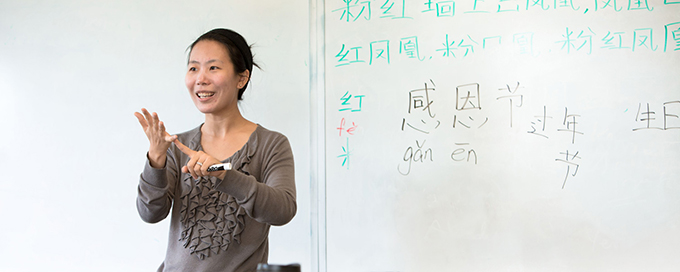
Mandarin Chinese is seen as being of increasing strategic importance, and in recent years there’s been a growing number of students taking up the language in schools across the UK.
There were more than 3,500 GCSE entries for Mandarin Chinese in 2018. But it’s not just China’s global dominance that makes Mandarin an appealing alternative to learning a European language. For students, it’s exciting and opens up a window into other cultures and ways of thinking.
Take the character for home and family 家 – which is a pig under a roof – many students are keen to find out why. New learners of the language are also always pleased to discover that verbs don’t change – so no having to remember different endings off by heart – and there are no tenses in Mandarin Chinese.
The learning of Chinese is taking off globally, so there are many new and innovative resources for students. China is also keen to welcome guests and school students have been able to benefit from in-country learning – supported financially by Chinese host institutions during their stay. Many come back home and realise the opportunities to work in China or with Chinese companies in their future will be huge.
Chinese in schools
As a new subject in a school, Chinese teachers (whether native or non-native speaker) tend to see themselves as pioneers. And they are often under pressure to establish their departments and achieve good results. This can mean learners have plenty of extra support and are motivated by highly focused teachers.
Students are often taught in precisely the same way as they would be taught for a European language, despite the structural differences of Chinese. Teachers start with a communicative approach –- so learners have to get to grips with more complex characters early. For instance 我喜欢 are the characters for “I like”.
Given a free rein, the teacher might choose to build up simpler characters to start with eg 人 and 口 – which mean people and mouth separately. These can then be put together as a compound, meaning population 人口.
Speaking and writing
The UCL Institute of Education has been supporting schools to teach Mandarin Chinese since 2007. Students can also now take part in the Department for Education’s Mandarin Excellence Programme, which is delivered in schools with support from a team of specialists at the UCL Institute of Education. The students learn Chinese for eight hours a week –- four taught hours and four hours of self-study – from year seven onward.
The programme is already having substantial results with 64 schools and more than 3000 pupils already on track to reach high levels of proficiency during their time at school. The first cohort of students are just joining year three of the programme and already able to speak and write Chinese to a high standard.
As well as delivering the programme and helping to train more Mandarin teachers, UCL Institute of Education is running a pilot for a significant project in schools to investigate the cognitive benefits of learning Chinese. We hope to discover how the brain functions differently when learning Chinese and the benefits this can have on schoolchildren.
A growing trend
But in all the noise about Chinese learning, perspective needs to be maintained about the numbers. In some schools Chinese is thoroughly embedded into the curriculum as a language offered alongside French, Spanish and German, but according to the British Council’s most recent Language Trends survey, Chinese is only offered as a GCSE option in 8% of state schools and 32% of independent schools.
At A-level, numbers are increasing, but this may mask the fact that a good number of those being examined will be native speakers of Chinese – or those with family background in the language.
What is clear though is that given this rise in interest, many more qualified teachers of Chinese are needed – as is much more research on best practice in teaching what is a relatively new language in schools.
This is important, because it is vital there is wider access to and better provision of Mandarin Chinese, if more students are to learn this language. But for this to happen, more schools need to start taking it seriously – by placing it alongside the traditional “foreign” languages (French, German and Spanish) that are typically learnt in the classroom.
Author Bio: Katharine Carruthers is Pro-Vice-Provost East Asia at UCL
